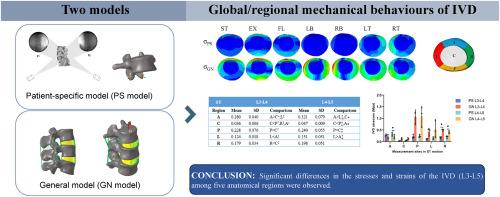IVD 对 7 种不同运动的机械响应的区域性变化:结合有限元分析和 DFIS 的活体研究。
IF 3.3
2区 医学
Q2 ENGINEERING, BIOMEDICAL
Journal of the Mechanical Behavior of Biomedical Materials
Pub Date : 2024-10-18
DOI:10.1016/j.jmbbm.2024.106785
引用次数: 0
摘要
腰椎间盘(IVD)的异常机械性能通常被认为是椎间盘退变(IDD)的直接指标。然而,目前的方法无法评估患者特定的 IVD 在体内运动时的机械性能。本研究建立了一个患者特异性(PS)模型,该模型结合了双透视成像系统(DFIS)获得的腰椎运动学参数和有限元(FE)方法,首次揭示了体内 IVD 在七种运动下的力学行为。本研究招募了三名健康参与者。研究人员通过 CT 图像创建了 L3-L5 脊柱的有限元模型。同时,参与者需要在 DFIS 中采取特定姿势,包括直立、屈曲、伸展、左侧和右侧弯曲以及左侧和右侧轴向扭转。将 CT 图像与 DFIS 图像配准计算出的体内运动学参数作为有限元模拟的加载条件。发现 PS 模型与采用广义力矩作为加载条件的 GN 模型在 von Mises 应力和主应变方面存在显著差异,前者的应变比 GN 模型低 76.74%。此外,在 IVD 的五个解剖区域(L3-L5)也发现了相当大的差异。在所有运动中,中心区域(髓核)的应力最低,而在伸展运动中,后部区域的应力最高。因此,椎间盘突出症患者应避免进行伸展运动等活动,因为后部是椎间盘突出的部位。结合体内运动学和有限元模拟的 PS 模型显示了设计和评估患者专用植入物的潜力。本文章由计算机程序翻译,如有差异,请以英文原文为准。

Regional variations of mechanical responses of IVD to 7 different motions: An in vivo study combined with FEA and DFIS
The abnormal mechanical behaviour of a lumbar intervertebral disc (IVD) is commonly recognized as a direct indicator of intervertebral disc degeneration (IDD). However, current methods cannot evaluate the patient-specific mechanical performance of an IVD in vivo during movement. This study establishes a patient-specific (PS) model that combines the kinematics parameters of the lumbar spine obtained with a dual fluoroscopic imaging system (DFIS) and a finite-element (FE) method for the first time to reveal the mechanical behaviours of IVDs in vivo under seven motions. Three healthy participants were recruited for this study. CT images were obtained to create finite-element models of L3-L5 spine segments. Meanwhile, participants were required to take specific positions including upright standing, flexion, extension, left and right lateral bending, as well as left and right axial torsion in the DFIS. The in vivo kinematic parameters, calculated by registering the CT images with images obtained with DFIS, were considered as loading conditions in FE simulations. Significant differences of von Mises stresses and principal strains were found between PS model and GN model which employing a generalized moment as loading conditions, former resulting in up to 76.74 % lower strain than the GN model. Also, considerable differences were observed for five anatomical regions of the IVD (L3-L5). Under all motions, the stress in the centre region (nucleus pulposus) was the lowest, while the stress in the posterior region was the highest in extension motion. Therefore, activities such as stretching with an extension, should be avoided by patients with a herniated disc, in which the posterior region was the herniation site. The PS model combining in vivo kinematics and FE simulations shows the potential in the design and assessment of patient-specific implants.
求助全文
通过发布文献求助,成功后即可免费获取论文全文。
去求助
来源期刊

Journal of the Mechanical Behavior of Biomedical Materials
工程技术-材料科学:生物材料
CiteScore
7.20
自引率
7.70%
发文量
505
审稿时长
46 days
期刊介绍:
The Journal of the Mechanical Behavior of Biomedical Materials is concerned with the mechanical deformation, damage and failure under applied forces, of biological material (at the tissue, cellular and molecular levels) and of biomaterials, i.e. those materials which are designed to mimic or replace biological materials.
The primary focus of the journal is the synthesis of materials science, biology, and medical and dental science. Reports of fundamental scientific investigations are welcome, as are articles concerned with the practical application of materials in medical devices. Both experimental and theoretical work is of interest; theoretical papers will normally include comparison of predictions with experimental data, though we recognize that this may not always be appropriate. The journal also publishes technical notes concerned with emerging experimental or theoretical techniques, letters to the editor and, by invitation, review articles and papers describing existing techniques for the benefit of an interdisciplinary readership.
 求助内容:
求助内容: 应助结果提醒方式:
应助结果提醒方式:


